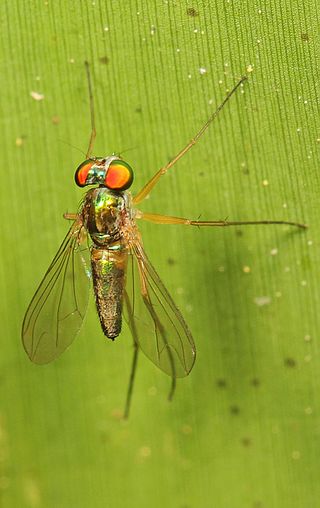
Amblypsilopus is a genus of flies in the family Dolichopodidae. It is a large genus, with about 350 species recorded. However, it is possibly polyphyletic.
Bickeliolus is a genus of flies in the family Dolichopodidae. It was originally a subgenus of Ethiosciapus, but was later raised to genus rank in 1998.
Chaetogonopteron is a genus of flies in the family Dolichopodidae.

Chrysosoma is a genus of flies in the family Dolichopodidae. It is a large genus, with more than 200 species distributed in the Old World and Oceania.
Corindia is a genus of flies in the family Dolichopodidae. It is known mainly from the Afrotropical and Australasian realms, with a single species from the Palaearctic realm and an undescribed species also known from the Neotropical realm. The genus was first described in 1986 by Daniel J. Bickel, who originally considered it to be the sister group of the genus Thrypticus. Bickel later suggested that Corindia may represent a plesiomorphic and paraphlyetic assemblage from which Thrypticus arose.
Craterophorus is a genus of flies in the family Dolichopodidae from the Afrotropical realm. It is endemic to the islands of the western Indian Ocean.
Ethiosciapus is a genus of flies in the family Dolichopodidae.
Gigantosciapus is a genus of flies in the family Dolichopodidae.
Mascaromyia is a genus of flies in the family Dolichopodidae, endemic to the western Indian Ocean islands. It is named after the main distribution of the genus, the islands of the submarine Mascarene Plateau, combining it with "myia".
Mesorhaga is a genus of flies in the family Dolichopodidae.

Parentia is a large genus of flies in the family Dolichopodidae.
Plagiozopelma is a genus of flies in the family Dolichopodidae.

Sybistroma is a genus of flies in the family Dolichopodidae. It includes over 50 species, described mainly from the Palaearctic and Oriental realms. A single species is known from the Afrotropical realm. Until 2005, the genus was thought to be restricted to the Mediterranean in distribution, with five known species. It was recently expanded to include the former genera Hypophyllus, Ludovicius and Nodicornis, as well as some species of Hercostomus.
Telmaturgus is a genus of flies in the family Dolichopodidae. It has a cosmopolitan distribution.

Sciapodinae is a subfamily of flies in the family Dolichopodidae. Members of the subfamily possess several ancestral characteristics of the family, such as branched vein M1+2 in the wings (though M2 is absent or reduced in Mesorhagini) and a pedunculate hypopygium. They also typically have a deeply excavated vertex, giving their heads the appearance of a dumbbell when viewed from the front.

Medeterinae is a subfamily of flies in the family Dolichopodidae.
Grootaertia is a genus of flies in the family Dolichopodidae from the Afrotropical realm. The genus is named after the Belgian entomologist Patrick Grootaert.

Peloropeodinae is a subfamily of flies in the family Dolichopodidae. In some classifications, the genera of the subfamily are included in Sympycninae. According to a molecular phylogenetic analysis of the family Dolichopodidae by Germann et al. (2011), the subfamily is polyphyletic.

Chrysosomatini is a tribe of flies in the family Dolichopodidae.






